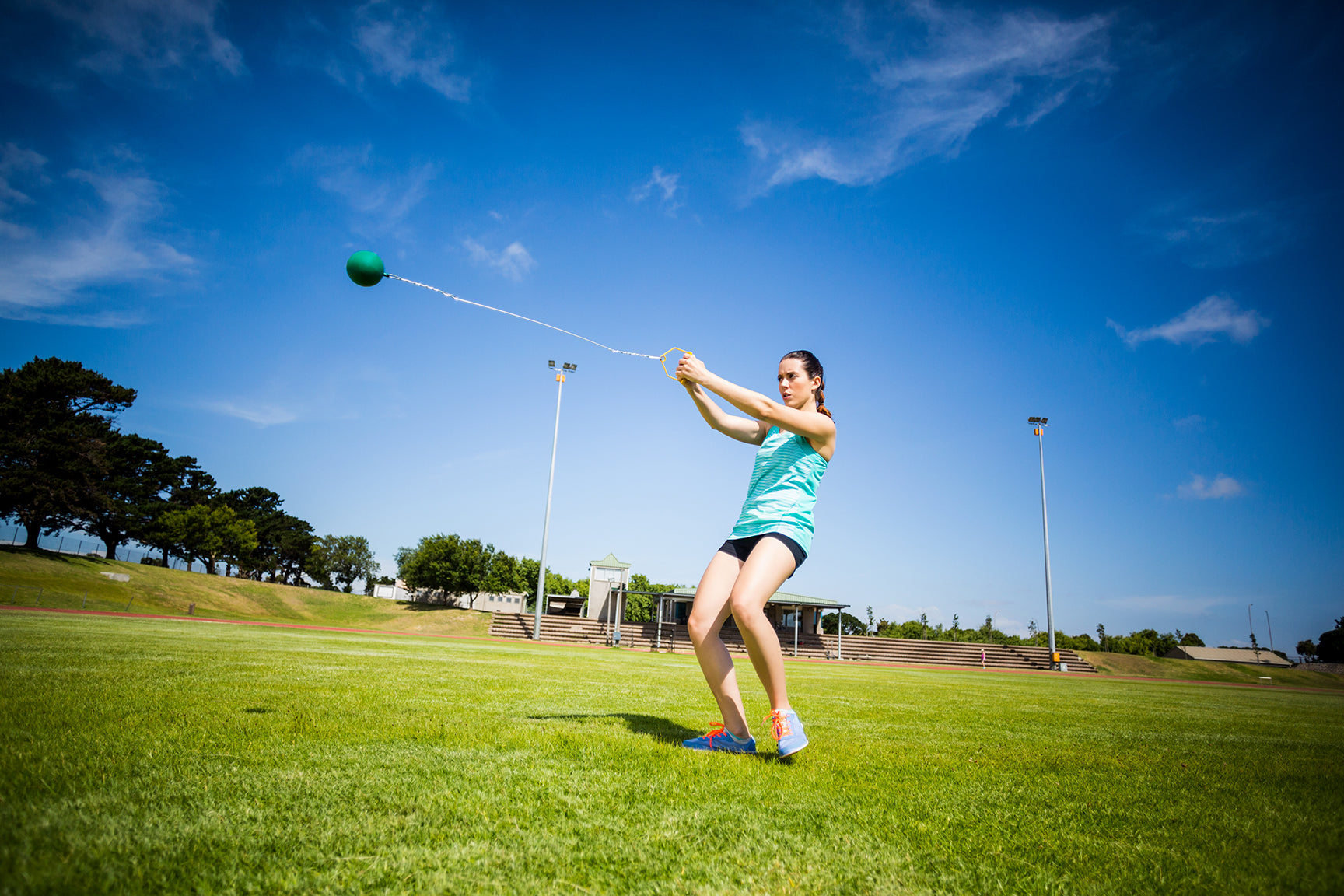
Hammer training drills by England Throws Camps
Our coaching partner England Throws Camp has developed a programme of drills for hammer throwers. These are specific exercises for athletes who want to to improve their technique - the next level up from the general fitness and strength training in the garden grind. Use your time wisely during lock-down and after.
This is the second in a series which will cover the full range of throw events.
1: Dominant Side SwingsWhy Do it?
Swings are an essential element of any throw as the athlete prepares to transition from a static to dynamic (rotating) movement. Good swings set up the throw by promoting a good entry into the first turn, whether that is to be a toe or heel turn.
Coaching Tips
-
The athlete should be stable with their weight somewhere between their feet and with not too much movement of the hips or upper body.
-
Both feet should remain fairly well fixed to the ground without too much heel lifting or other movement.
-
The inclination of the hammer orbit should not be too steep.
-
The elbow of the non-glove hand should remain close to the body wherever possible.
-
Tension should be maintained in the hammer wire at all times so that the orbit looks smooth and nearly circular.
2: Reverse Swings
Why Do it?
Reversing the swing helps the athlete feel what they are doing much more effectively and balances the development of strength on both sides of the body. This helps improve mobility and reduce the risk of injury whilst increasing proprioceptive feedback and enhancing the learning experience.
Coaching Tips
- Look for all the same points as for normal swings. The closer the athlete is able to reproduce a mirror image of their dominant-side technique swings the better it is overall.
3: Walking Swings
Why Do it?
The walking swing helps develop a sense of awareness of the body and the muscles used as the athlete swings the hammer. These swings require greater coordination than static swings and help promote use of the core and interstitial pressure to maintain good posture throughout the exercise.
Coaching Tips
- Look for all the same points as for normal swings.
- Watch for even steps with both feet and in both directions.
- See that the athlete can walk in a straight line and change direction as and when required without needing extra swings between movements.
- Try reversing the walking swings as for the static swings.
4: Hammer Rolls
Why Do it?
Rolling the hammer and keeping it on the ground requires a sense of where the hammer is and the patience to work with the hammer throughout the full turn. It also give the athlete chance to practice good posture and correct turning of the feet as the turns are generally much slower than in a throw. Initiating this drill with a walk around also helps with finding the correct point for the athlete as to when to engage the hammer and “sit” into their turn position whilst waiting for the hammer to be in the correct position to initiate the turn.
Coaching Tips
- Watch for the hammer being pushed in front of the athlete and not being dragged along behind or to their side.
- The arms should form an isosceles triangle with the shoulders (both arms are at an equal angle to a line drawn through the shoulders and meet at the mid-point of that line when viewed from the front) and should be long and relaxed.
- Balance should be maintained throughout with the hammer feeling like it’s being “pushed” with the whole body around its orbit on the floor.
- The hammer must remain on the floor. This can be developed over time to allow for lifting the hammer off the floor but only once the athlete can manage 5 – 8 turns with it remaining on the floor.
5: Windmill Turns
Why Do it?
The windmill turn helps promote balance and a sense of working with the momentum of the implements held in the hands. This allows the weights to aid the turn so that the athlete can feel their way into timing the movement of their feet and improving it to find a sweet spot for initiating their turns.
Coaching Tips
- Good balance should be maintained throughout.
- The athlete should appear to be turning lightly on their feet and be maintaining athletic posture with the hips forward at all times.
- Turns should be smooth and controlled without any hard impacts of the feet on the ground.
- The feet should both be continuously turning in order to make the turns smooth.
- Turns should accelerate smoothly but take care to stop before they get out of control.
6: Bar Turns
Why Do it?
Bar turns promote the athletic position with hips forward throughout the turn. They require the athlete to remain balanced and hold their weight over the non-dominant foot as the dominant foot comes down.
Coaching Tips
- Bar should be held behind (not on top) of the shoulders as this promotes use of the upper thorax during the turn.
- Hips should be forward and above the feet as much as is possible
- Back should be straight with no lordosis (arch)
- Turns should be rhythmical and progressive
- Dominant foot should land lightly and then be capable of being picked up to feel the balance position.
- 1 or more turns can be performed as long as the athlete can stop and take the dominant foot off the ground again at the end of the turns. This shows balance has been maintained throughout all the turns.
7: Front Bag Turns
Why Do it?
Bag turns help to develop strength in the athletic posture by making it harder to keep hips forward whilst remaining balanced in the turn. This is advanced technique as younger athletes may tend to arch their back and drop their hips backwards to balance the pull of the bag.
Coaching Tips
- Hips should be forward and above the feet as much as possible
- Back should be straight with no lordosis (arch)
- Turns should be rhythmical and progressive
- Feet should be smooth and continuously turning on the ground.
8: Band Twists
Why Do it?
Band Twists help improve the athletes core stability in a dynamic position. It encourages the use of interstitial pressure to maintain position against resistance whilst still being able to move the feet in a technically effective manner. Use different strength bands as the athlete progresses in the abilities.
Coaching Tips
- Hips should be forward and above the feet as much as is possible
- Back should be straight with no lordosis (arch)
- Feet should be smooth on the ground.
- Arms should remain evenly in front of the athlete forming an isosceles triangle with the shoulders.
- The athlete should turn though a full 90’ in each turn.
9: Double Band Twists
Why Do it?
This is an advanced version of the band twist, requiring the athlete to maintain their position in both directions, thus promoting balanced development and skill learning as well as the ability to move more easily from static to dynamic positions in both directions.
Coaching Tips
- Hips should be forward and above the feet as much as is possible
- Back should be straight with no lordosis (arch)
- Feet should be smooth on the ground.
- Arms should remain evenly in front of the athlete forming an isosceles triangle with the shoulders.
- The athlete should turn though a full 90’ in each direction.
10: Kettle Bell Swings
Why Do it?
Kettle Bell Swings develop core strength and stability whilst being able to maintain balance and movement both in a linear (vertical) and rotational (horizontal) direction. This is a complex movement and can be difficult to time for young athletes so be careful to use light implements to begin with.
Coaching Tips
- Hips should be forward and above the feet as much as is possible
- Back should be straight with no lordosis (arch)
- Feet should be smooth on the ground.
- The athlete should turn 180’ with each turn and remain balanced.
11: Hanging Band Twist
Why Do it?
This is an advanced exercise to emphasise the ability of the athlete to “hang” on the hammer as it turns towards the high-point. This is the region in which the hammer is doing the work as the athlete begins to turn underneath it towards the start of the next turn. In this drill the athlete works to pull the band away from the high-point where the band is secured then to turn back under the pull of the band and picking up the right foot to hold in the “hanging” position.
Coaching Tips
- Good athletic swing posture is maintained at all times.
- Arms should remain evenly in front of the athlete forming an isosceles triangle with the shoulders.
- The band should remain under tension at all times so that the athlete can “hang” off it and allow the band to do some of the work.
- The hands should pass in front of the athlete before they begin to lift off with the dominant-side foot, although they can lift at whatever time suits them after that.
- The athlete should be able to remain in the “hanging” position on balance for a second before lowering their leg.
12: 2-Swing Entry
Why Do it?
This exercise is the culmination of the previous drills and uses all those skills in achieving a good technical entry into the first turn. The aim of the 2-swing entry is to promote a good rhythm for entry into the first turn. It sets up the correct timing for acceleration and gives a feeling for the slingshot effect of the hammer entry being timed correctly. The first swing is comfortable and the second swing is pushed from behind the head towards the low-point then allowed to turn towards the end of the single-support phase.
Coaching Tips
- Good athletic swing posture is maintained at all times.
- The hammer wire should remain under tension at all times so that the hammer orbit is roughly circular.
- Acceleration should be from behind the athletes head to low-point.
- Hammer should be allowed to pass in front of the athlete so that they are looking at or behind the hammer when it reaches the low-point.


Leave a comment